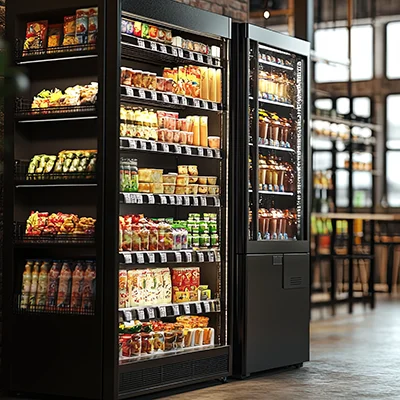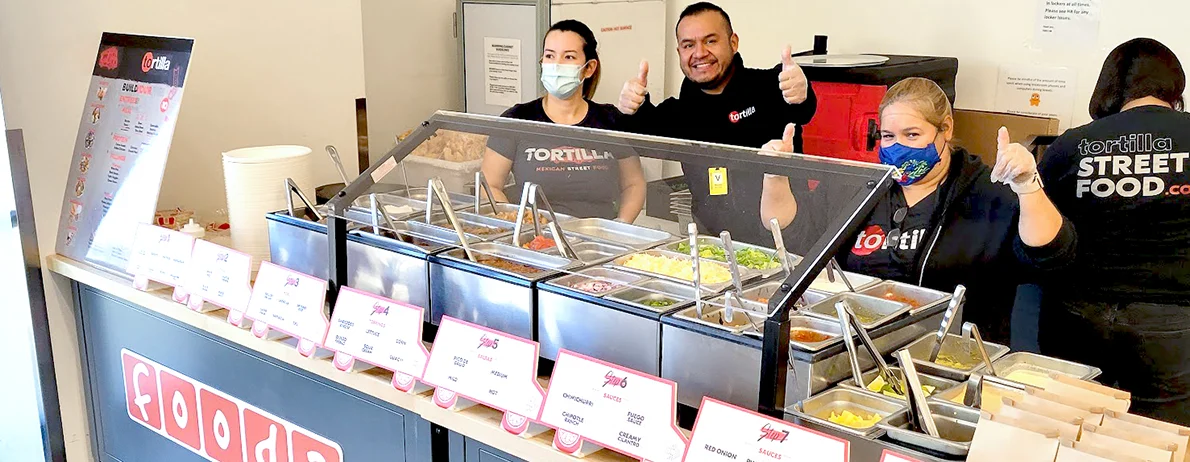

Managing a distribution or data center means coordinating an endless number of moving parts, but there's one challenge that often stands out from the rest: feeding your hard working team.
When your facility runs 24/7 or sits in an industrial park miles from the nearest restaurant, meal breaks become a logistical puzzle. Your third shift clocks in when everything's closed and your entire team works physically demanding jobs that require real fuel (not just vending machine snacks).
That’s why we’ve created this guide that covers why workplace food matters more than you might think, the unique challenges facing data center facilities and distribution centers, and practical solutions that actually work.
These aren't your typical 9-to-5 office environments. Distribution centers and data centers run around the clock, with employees working overnight, swing, and graveyard shifts that traditional food services weren't designed to support.
Most facilities are located in industrial areas where nearby restaurants are few and far between and some employees face a 20-30 minute drive just to grab a meal, meaning your employees are spending more time outside of the workplace, and less time working.
Meanwhile, the work itself is physically demanding, requiring sustained energy and focus that chips and candy bars don’t provide. But when you're managing hundreds of people across three or four shifts, coordinating workplace dining becomes a major operational challenge many managers aren’t taking the time to solve.
The connection between something as simple as providing a meal and employee satisfaction runs deeper than most facility managers realize. In industries with notoriously high turnover, every advantage to retain employees counts, and a well structured workplace dining program is a major driver in employee satisfaction.
When your team is working a 12-hour overnight shift, access to high-quality food becomes a real requirement to keep operations running smoothly as it keeps your team fueled, focused, and excited to come back tomorrow.
By meeting their needs, you make their lives easier and signal to your employees that you value them enough to invest in their health and daily experience at work, which directly impacts morale and company culture.
Since almost all labor markets are competitive now, offering convenient meal options is one of the most cost-effective ways to give you a recruiting edge. Job seekers are quick to compare benefits packages, and workplace food programs factor into their decisions more now than ever before.
Most facility managers face similar struggles when it comes to feeding their teams, review the table below to get a better understanding of them:
These challenges may come in waves or persistently plague your efforts but that doesn’t mean there isn’t a solution…
If you’re able to take any of the 5 steps below, it will help you improve the daily experience your employees have surrounding their meal break.

Traditional vending machines are collecting dust these days. They’re filled with processed snacks that just don't cut it anymore. Your team needs real food that provides sustained energy for physical work.
If you want to stay on the self-service route, modern alternatives like smart fridges offer same-day made salads, protein boxes, and substantial meals available 24/7. For example, Farmer's Fridge stocks daily and has grab-and-go options that can be accessed any time. Options like this provide diverse, great tasting food to your employees at their convenience, no matter the hour.
You can also stock the pantry in your facility, expanding on the smart-fridge concept by offering a broader selection. Employees can choose from customized options in a micro-market, healthy snacks that they know and love, and refreshing beverages without the hassle of leaving to get them.
Your 3rd shift team deserves more than cold leftovers from the day shift. True 24/7 food access means providing well-rounded options regardless of when someone clocks in.
The smart fridges and pantries mentioned above stay stocked around the clock, giving overnight workers the same meal options as day shift employees. But for more substantial meal offerings, scheduled deliveries or Popup restaurants can align with shift changes to make sure food is on site when it’s needed most.

Give your hardworking team something to look forward to! Catering different types of food from local restaurants keeps breaks exciting. Employees get to discover new favorites or cuisines and build stronger ties with the restaurant owners in their community.
One day might feature authentic tacos from a popular food truck, while the next day could bring Mediterranean cuisine from the top-rated spot in town. Don’t forget that dietary accommodations matter too. Offering gluten-free, vegan, halal, and other options ensures everyone on your team can find something they'll enjoy.
Instead of managing five vendors and ten invoices, imagine one platform handling everything. Modern workplace food solutions consolidate vendor coordination, ordering, invoicing, and dietary tracking into a single system.
Partner with a company that can eliminate the administrative work and overhead. You should get one point of contact, one invoice, and a single platform that tracks everything your team needs. The amount of time saved on vendor management can be redirected towards operational priorities or projects.
Taking advantage of technology or AI to optimize your processes is becoming commonplace for businesses across all industries. In dining services, these systems reduce food waste while providing a selection of restaurants they’ll want to order from.
When looking for a food services partner, make sure you ask these 7 questions and verify the technology they have in place meets your needs. When they have a technology driven approach, your food program naturally gets better over time by automatically adapting to your team's preferences.

If you’re reading this, we know you’re looking for the perfect partner to improve your workplace dining program and that’s exactly where Fooda comes.
Fooda handles the heavy lifting when it comes to dining at distribution and data center facilities. We coordinate with restaurants, manage delivery logistics, and track employee preferences. This means you get variety, reliability, and convenience without having to think twice about it.
Our solutions include rotating Popup restaurants, consolidated lunch delivery, pantry stocking options, and more. We maintain relationships with over 2,500+ locally owned restaurants and vendors so you don’t have to. For larger facilities, we also offer full cafeteria management that handles everything from sourcing ingredients to staffing.
The technology behind our platform uses machine learning to optimize menus, reduce waste, and improve service reliability. Most importantly, we work for all shift schedules. Whether your employees clock in at 6 AM or midnight, Fooda ensures they have access to the top food options.
Ready to improve the food options at your data center or distribution facility? Design your own food program and then get in contact with Fooda to let us handle the implementation.
The best options combine 24/7 accessibility with nutritional variety and convenience. Smart fridges stocked with fresh meals, rotating Popup restaurants for hot food, and pantries with diverse selections all work well. The key is ensuring every shift has equal access to food, not just whatever's left over from earlier in the day.
Data-driven platforms that track consumption patterns help dramatically. These systems identify which meals your employees actually order, allowing you to adjust quantities and options accordingly. Predictive analytics can forecast demand based on shift schedules and historical trends, always making sure you stock the right amount of food without wasting it.
Fooda technology makes this easier than ever. We track dietary preferences and restrictions automatically, allowing employees to filter menu options by their needs. Offering variety through rotating restaurants naturally increases the likelihood that everyone finds options they can enjoy. The goal is providing genuine choice, not just one token vegetarian option.
Absolutely. Solutions like smart fridges, pantries, and scheduled deliveries ensure round-the-clock access. The key is designing the program specifically for shift work rather than adapting a traditional office lunch model. When implemented correctly, overnight workers get the same experience as day shift employees.